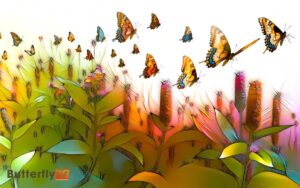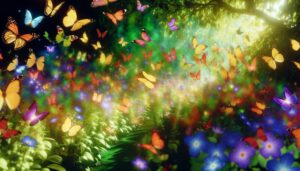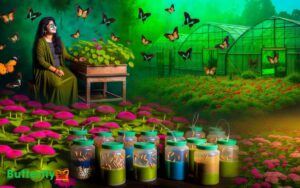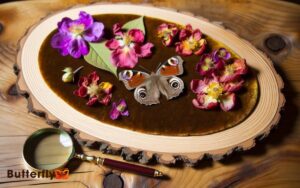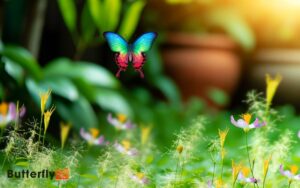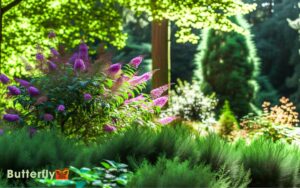Do Calla Lilies Attract Butterflies? Yes!
Yes, Calla lilies attract butterflies. Their brightly colored spathes, especially in shades like red, orange, and yellow, are highly visible to butterflies, which have compound eyes that detect ultraviolet light.
The high-energy nectar produced by Calla lilies provides essential nutrients, making them an attractive food source for butterflies.
Additionally, the linalool scent emitted by these flowers strongly appeals to butterflies, further enticing them. Ideal soil conditions and sufficient sunlight, along with compatible companion plants, create an inviting environment.
To maximize butterfly visits, consider the balance of color, scent, and nectar production offered by Calla lilies. Learn more to create the perfect butterfly garden.
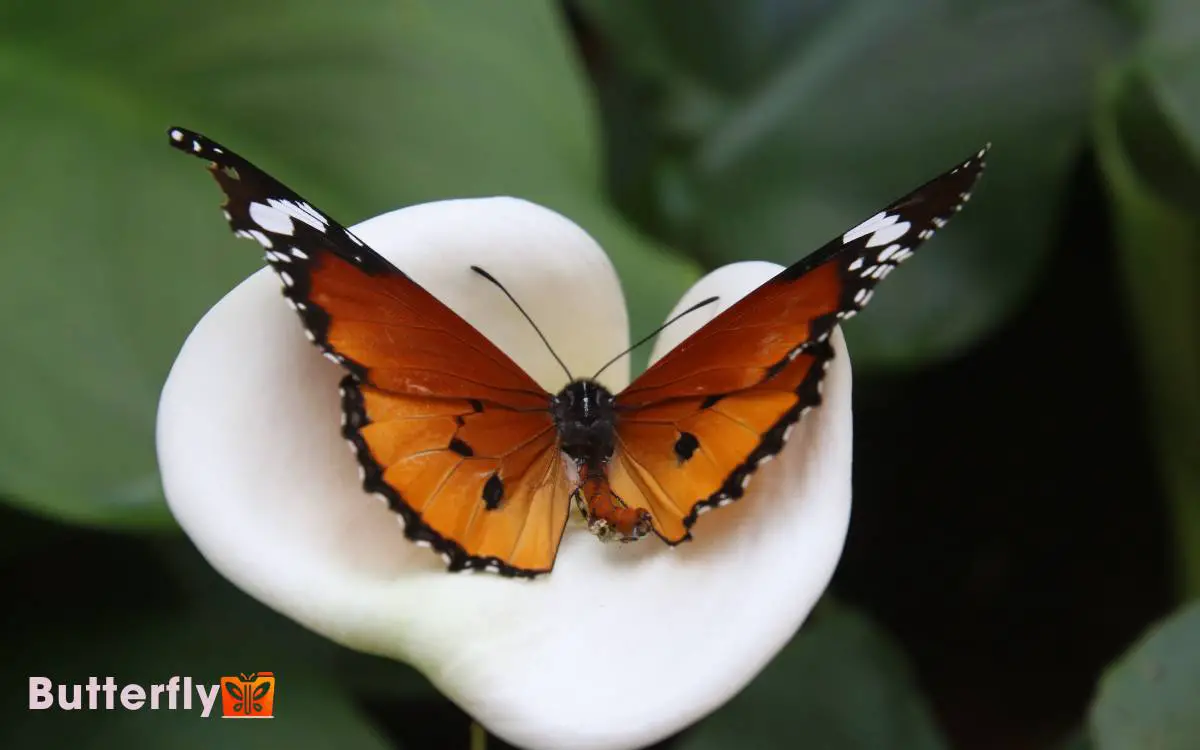
Key Takeaways
Understanding Calla Lilies
Calla lilies, scientifically known as Zantedeschia, are perennial plants native to southern Africa, distinguished by their unique spathe and spadix floral structures. The spathe, often mistaken for a petal, is a modified leaf that encircles the spadix, a central spike covered in tiny flowers.
You’ll find these plants thrive in well-drained, moist soils with ample sunlight to partial shade. Their rhizomatous root system ensures they can store nutrients efficiently, leading to robust growth and recurrent blooming.
Each vibrant spathe can range in color from classic white to bold pinks, yellows, and purples, adding aesthetic appeal to gardens.
Understanding these botanical nuances allows you to cultivate calla lilies effectively, promoting their health and maximizing their ornamental potential.
Butterfly Attraction Basics
You’ll find that butterflies exhibit specific pollination preferences, often gravitating towards flowers with abundant nectar and accessible structures.
Their attraction is markedly influenced by flower color, with bright hues like red, orange, and yellow being the most effective at drawing them in.
Butterfly Pollination Preferences
Have you ever wondered what specific characteristics make certain flowers more appealing to butterflies for pollination?
Butterflies possess a keen sense of sight and smell, essential in seeking nectar sources. They favor flowers with accessible nectar, typically those with flat, wide surfaces that allow them to land and feed comfortably.
Flowers with tubular shapes also attract butterflies, as these structures facilitate nectar extraction by their proboscises.
Additionally, butterflies are drawn to the presence of ultraviolet nectar guides, which are invisible to the human eye but highly conspicuous to them. These guides help direct butterflies to the nectar source efficiently.
Moreover, butterflies prefer flowers that bloom during the day when they’re most active, enhancing their role as effective pollinators.
Flower Color Influence
Did you know that the vivid colors of flowers play an essential role in attracting butterflies, as these insects rely heavily on their visual perception to locate suitable nectar sources?
Butterflies are especially drawn to bright hues such as red, yellow, orange, pink, and purple. Their compound eyes are finely tuned to detect ultraviolet light, which many flowers reflect, enhancing their visibility.
This visual allure is important for pollination, as butterflies flit from bloom to bloom in search of nectar. Calla lilies, with their striking spathes, can captivate butterflies if their colors fall within the butterflies’ preferred spectrum.
Understanding this color attraction can help you create a butterfly-friendly garden, ensuring these delicate pollinators visit and thrive in your outdoor space.
Pollination and Butterflies
In the intricate dance of pollination, butterflies play a significant role by transferring pollen as they feed on the nectar of Calla lilies. As you observe these delicate creatures, you’ll notice their proboscis extending into the spadix of the Calla lily, accessing the rich nectar.
During this process, pollen grains adhere to their legs and bodies. When they move to another bloom, they inadvertently transfer this pollen, facilitating cross-pollination.
Unlike bees, butterflies exhibit a more delicate and intentional approach to nectar feeding, ensuring minimal disturbance of the flower’s reproductive structures.
This precise interaction enhances the genetic diversity within Calla lilies, promoting robust plant populations. Understanding this symbiotic relationship underscores the essential role butterflies play in the ecosystem.
Calla Lily Characteristics
Renowned for their elegant trumpet-shaped spathes and lush green foliage, Calla lilies (Zantedeschia spp.) exhibit a distinctive morphology that sets them apart in the botanical world.
You’ll notice their spathes, which are modified leaves, encase a central spadix covered in tiny flowers. These features contribute to their unique charm.
Key characteristics include:
- Spathes: Often mistaken for petals, these come in various colors.
- Spadix: A spike at the center, hosting numerous minute flowers.
- Foliage: Broad, arrow-shaped leaves with a glossy finish.
- Growth Habit: Typically perennial, thriving in moist, well-drained soil.
- Size: Varies from compact to tall, with some reaching up to 3 feet.
Understanding these traits helps you appreciate the intricate beauty of Calla lilies.
Nectar and Butterflies
Butterflies are drawn to the nectar produced by Calla lilies, making these flowers an essential component in sustaining local butterfly populations.
Calla lilies secrete a high-energy nectar that provides critical nutrients like sugars, amino acids, and lipids. This nectar is crucial for butterflies’ metabolic processes, reproductive success, and overall survival.
When you plant Calla lilies in your garden, you’re creating a reliable food source that supports the energy needs of these pollinators. Moreover, the nectar serves as a lure, encouraging butterflies to frequent your garden, thereby increasing pollination efficiency.
Color and Butterfly Appeal
Beyond their nutrient-rich nectar, Calla lilies also captivate butterflies with their vibrant colors, which play a significant role in attracting these pollinators. Butterflies have excellent color vision, and they’re particularly drawn to bright, vivid hues.
The striking pigmentation of Calla lilies serves as a visual cue, guiding butterflies to their nectar reserves.
Here’s why these colors are so effective:
- Ultraviolet reflectance: Butterflies can see UV light, and many Calla lilies reflect UV patterns.
- Contrasting colors: Bright colors contrast sharply with green foliage, making them more noticeable.
- Specific hues: Red, orange, and yellow are especially attractive to butterflies.
- Color intensity: The deep, rich colors of Calla lilies stand out.
- Seasonal variation: Different colors bloom in different seasons, continuously attracting butterflies.
Scent and Butterfly Behavior
Frequently, the intoxicating scent of Calla lilies plays a pivotal role in influencing butterfly behavior, acting as an olfactory beacon that guides these pollinators to their floral targets.
You’ll find that butterflies possess highly sensitive chemoreceptors on their antennae, designed to detect specific volatile organic compounds (VOCs) emitted by flowers.
These VOCs vary in concentration and composition, orchestrating a chemical symphony that attracts butterflies from considerable distances.
| Chemical Compound | Scent Note | Butterfly Response |
|---|---|---|
| Linalool | Floral, Citrus | Strong attraction |
| Benzyl Acetate | Sweet, Jasmine | Moderate attraction |
| Phenylacetaldehyde | Honey-like | High attraction |
| Eugenol | Spicy, Clove | Variable response |
| Farnesene | Woody, Green | Mild attraction |
Understanding these chemical cues can help you cultivate a garden that effectively attracts and supports butterfly populations.
Garden Environment
To cultivate an ideal habitat for calla lilies and butterflies, you must prioritize well-draining, nutrient-rich soil with a slightly acidic to neutral pH.
Make sure your garden receives a balance of direct sunlight and partial shade to support the diverse needs of these species.
Proper sunlight exposure not only promotes vigorous growth in calla lilies but also attracts butterflies, enhancing the biodiversity of your garden ecosystem.
Optimal Soil Conditions
For ideal growth of calla lilies in a garden environment, the soil should be well-drained, rich in organic matter, and slightly acidic with a pH between 6.0 and 6.5. Confirming the soil meets these criteria helps your calla lilies thrive.
You should:
- Incorporate compost: This enhances soil fertility and structure.
- Test soil pH: Regular testing confirms the soil remains slightly acidic.
- Use mulch: Retains moisture and regulates soil temperature.
- Ensure proper drainage: Prevents waterlogging and root rot.
- Add organic fertilizers: Enrich the soil with essential nutrients.
Sunlight and Shade
Calla lilies thrive best with at least six hours of direct sunlight daily, though they can tolerate partial shade, particularly in hotter climates. You’ll notice that ideal photosynthesis occurs under these conditions, promoting vigorous growth and abundant blooms.
In regions with intense summer heat, providing afternoon shade can prevent leaf scorch and stress. Utilize a light meter to guarantee adequate luminosity, aiming for 10,000–12,000 lux. If planting in containers, consider moving them to track the sun’s path.
Shade tolerance enhances the plant’s versatility in diverse garden environments, but insufficient light can result in leggy stems and reduced flowering. By balancing sunlight and shade, you’ll make sure your calla lilies flourish, attracting butterflies with their vibrant, healthy blooms.
Companion Plants
When selecting companion plants for calla lilies, you should consider species that thrive in similar moisture-rich and well-drained soil conditions, such as hostas and astilbes.
These plants not only complement the aesthetic appeal of calla lilies but also share similar horticultural requirements, ensuring a harmonious garden environment.
Hostas offer broad, lush foliage that contrasts beautifully with the sleek, elegant blooms of calla lilies. Astilbes add a feathery texture and vibrant colors to your garden.
Consider the following companion plants:
- Hostas: Shade-tolerant with broad, lush leaves.
- Astilbes: Feathery plumes in various colors.
- Ferns: Provide a delicate, airy texture.
- Japanese Iris: Adds height and striking color.
- Heucheras: Offer a variety of leaf colors and patterns.
These choices create a visually enchanting and ecologically balanced garden.
Maintenance Tips
Proper maintenance guarantees your calla lilies thrive, showcasing their stunning blooms season after season. Begin by ensuring well-draining soil with a slightly acidic to neutral pH of 6.0-7.0.
Water them consistently, keeping the soil moist but not waterlogged. Fertilize monthly with a balanced 10-10-10 NPK fertilizer during the growing season.
Remove spent blooms to promote further flowering and prevent disease. If you live in a frost-prone area, dig up the rhizomes before the first freeze and store them in a cool, dry place.
Regularly inspect for pests like aphids and spider mites; treat infestations promptly with insecticidal soap. By following these steps, you’ll maintain robust, healthy calla lilies that enchant your garden year-round.
Observing Butterfly Visits
By maintaining your calla lilies meticulously, you’ll not only enjoy vibrant blooms but also attract a variety of butterflies, turning your garden into a lively haven for these enchanting pollinators.
To observe butterfly activity, consider these steps:
- Timing: Monitor during peak hours late morning to early afternoon.
- Environment: Create a hospitable habitat ample sunlight and minimal wind.
- Nectar Sources: Supplement with other nectar-rich flowers to diversify butterfly species.
- Water Sources: Include shallow water dishes or puddling stations for hydration.
- Documentation: Keep a journal or camera handy to record butterfly species and behavior.
Conclusion
To sum up, while calla lilies are stunning and offer some nectar, they aren’t top choices for butterflies due to their limited nectar production and structural makeup.
Butterflies prefer flowers with ample nectar and easy access.
However, by integrating companion plants like milkweed and zinnias into your garden, you’ll create a more butterfly-friendly environment.
Regularly observe your garden to see the butterflies’ preferences, ensuring a vibrant, pollinator-rich space.

